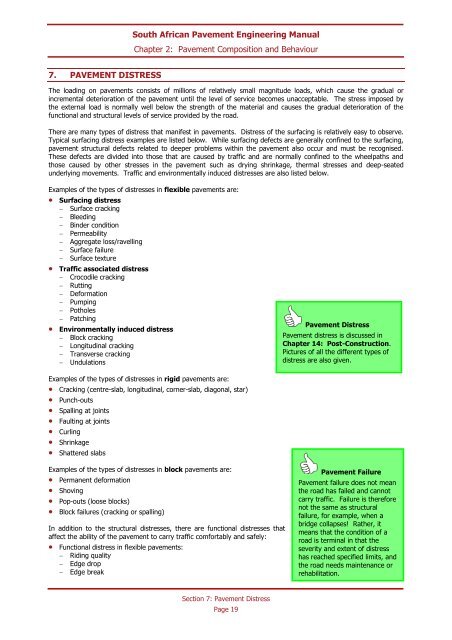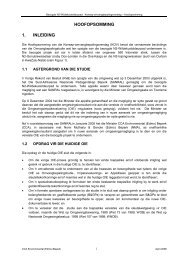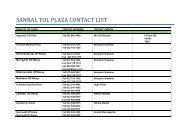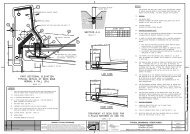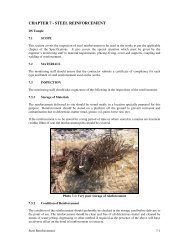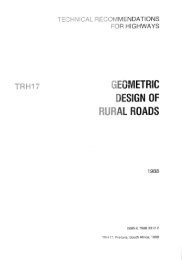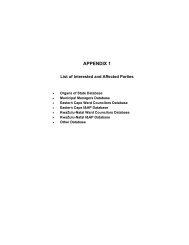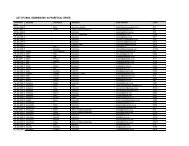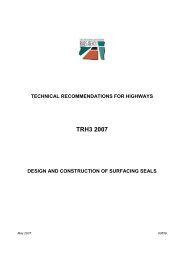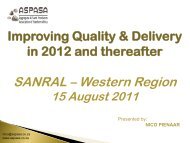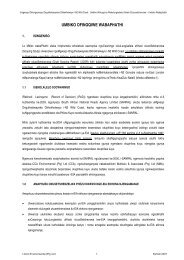SAPEM Chapter 2 - Sanral
SAPEM Chapter 2 - Sanral
SAPEM Chapter 2 - Sanral
You also want an ePaper? Increase the reach of your titles
YUMPU automatically turns print PDFs into web optimized ePapers that Google loves.
South African Pavement Engineering Manual<br />
<strong>Chapter</strong> 2: Pavement Composition and Behaviour<br />
7. PAVEMENT DISTRESS<br />
The loading on pavements consists of millions of relatively small magnitude loads, which cause the gradual or<br />
incremental deterioration of the pavement until the level of service becomes unacceptable. The stress imposed by<br />
the external load is normally well below the strength of the material and causes the gradual deterioration of the<br />
functional and structural levels of service provided by the road.<br />
There are many types of distress that manifest in pavements. Distress of the surfacing is relatively easy to observe.<br />
Typical surfacing distress examples are listed below. While surfacing defects are generally confined to the surfacing,<br />
pavement structural defects related to deeper problems within the pavement also occur and must be recognised.<br />
These defects are divided into those that are caused by traffic and are normally confined to the wheelpaths and<br />
those caused by other stresses in the pavement such as drying shrinkage, thermal stresses and deep-seated<br />
underlying movements. Traffic and environmentally induced distresses are also listed below.<br />
Examples of the types of distresses in flexible pavements are:<br />
Surfacing distress<br />
Surface cracking<br />
Bleeding<br />
Binder condition<br />
Permeability<br />
Aggregate loss/ravelling<br />
Surface failure<br />
Surface texture<br />
Traffic associated distress<br />
Crocodile cracking<br />
Rutting<br />
Deformation<br />
Pumping<br />
Potholes<br />
Patching<br />
Environmentally induced distress<br />
Block cracking<br />
Longitudinal cracking<br />
Transverse cracking<br />
Undulations<br />
Pavement Distress<br />
Pavement distress is discussed in<br />
<strong>Chapter</strong> 14: Post-Construction.<br />
Pictures of all the different types of<br />
distress are also given.<br />
Examples of the types of distresses in rigid pavements are:<br />
Cracking (centre-slab, longitudinal, corner-slab, diagonal, star)<br />
Punch-outs<br />
Spalling at joints<br />
Faulting at joints<br />
Curling<br />
Shrinkage<br />
Shattered slabs<br />
Examples of the types of distresses in block pavements are:<br />
Permanent deformation<br />
Shoving<br />
Pop-outs (loose blocks)<br />
Block failures (cracking or spalling)<br />
In addition to the structural distresses, there are functional distresses that<br />
affect the ability of the pavement to carry traffic comfortably and safely:<br />
Functional distress in flexible pavements:<br />
Riding quality<br />
Edge drop<br />
Edge break<br />
Pavement Failure<br />
Pavement failure does not mean<br />
the road has failed and cannot<br />
carry traffic. Failure is therefore<br />
not the same as structural<br />
failure, for example, when a<br />
bridge collapses! Rather, it<br />
means that the condition of a<br />
road is terminal in that the<br />
severity and extent of distress<br />
has reached specified limits, and<br />
the road needs maintenance or<br />
rehabilitation.<br />
Section 7: Pavement Distress<br />
Page 19


